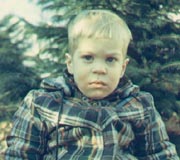|
© Copyright 1999-2000 Eileen Nicole Simon | ||
 Conrad, an often somber child |
||
|
Origin of the concept of infantile autism is widely attributed to Leo Kanner (1943). Kanner described the disorder as being present from birth. Descriptions of the disorder had been made at least as early as the late nineteenth century. Barr (1898) described a 22-year-old retarded man with a phenomenal memory and echolalic speech, and Barr cited use of the term echolalia in the German literature beginning with Romberg (1850). DeSanctis (1908) and Heller (1908) described children with autistic behaviors, and both used the term "dementia infantilis" in accordance with Kraepelin's term "dementia praecox" for the disorder now known as schizophrenia, which is manifested in late adolescence or early adulthood (Kraepelin 1904). Bleuler (1924) employed the term schizophrenia as a euphemism less stigmatizing than dementia praecox, and many reports of childhood schizophrenia appeared until well after Kanner (1943, 1946) introduced the term "early infantile autism." |